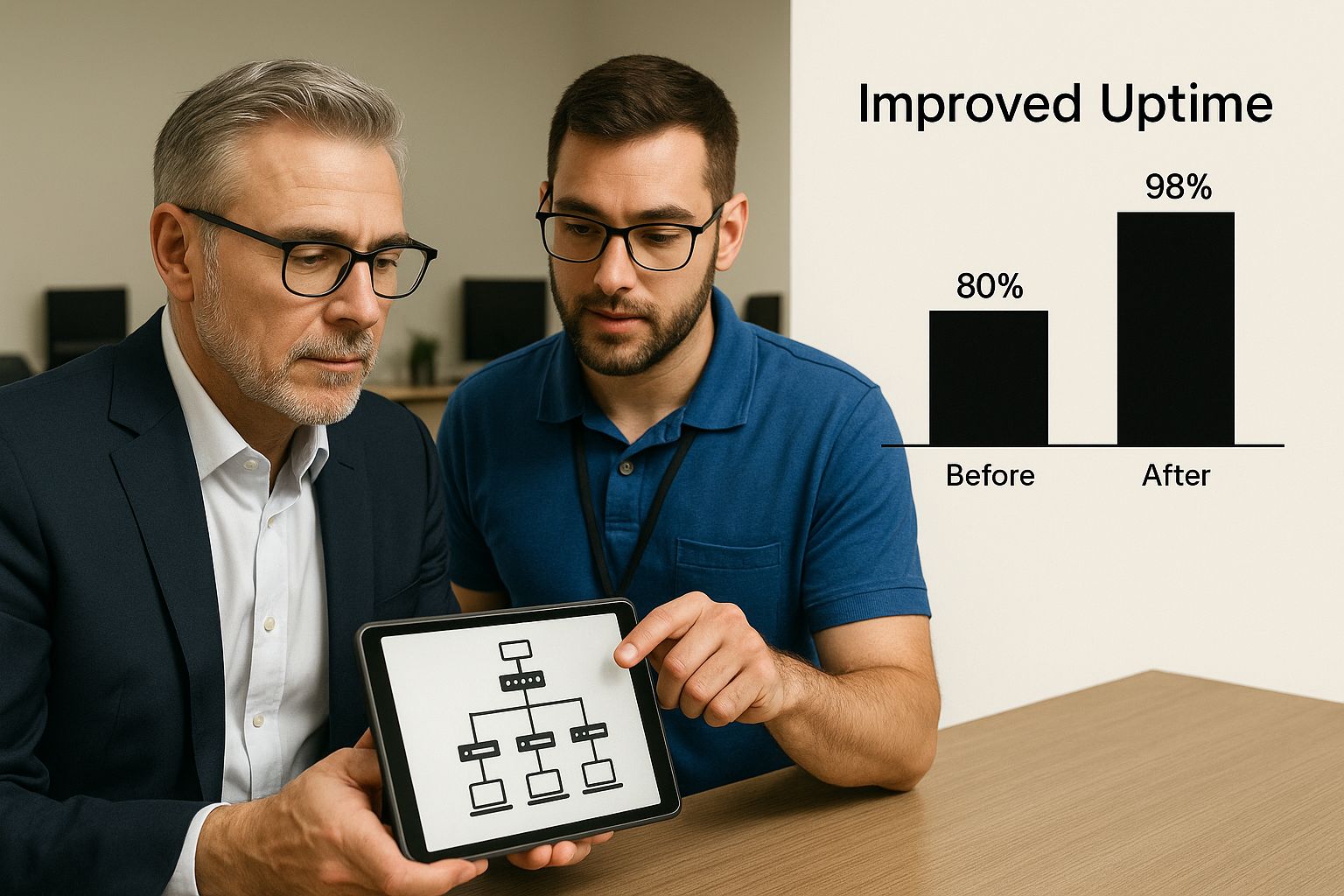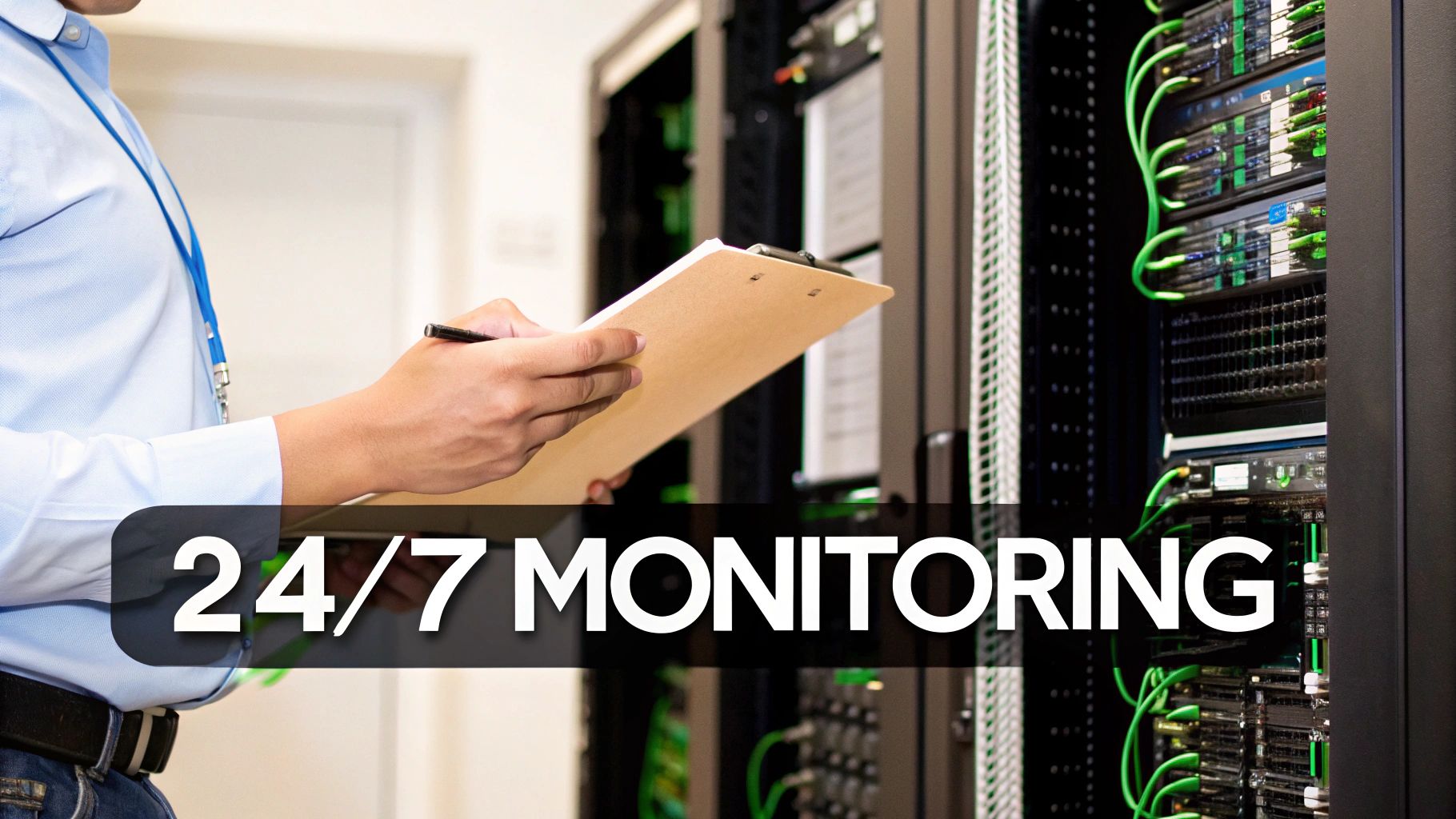Beyond Break-Fix: How Managed IT Services Transform Small Business
Traditionally, small businesses relied on the break-fix IT model, calling a technician only when something malfunctioned. This reactive approach often led to unexpected downtime, lost productivity, and unpredictable IT costs. However, managed IT services offer a proactive alternative that's changing the game for small businesses. Think of it as having a regular health check-up instead of only visiting the emergency room when seriously ill.
Proactive IT Management: A Shift in Approach
Managed IT services providers (MSPs) act as your virtual IT department, constantly monitoring your systems and addressing potential issues before they escalate. For example, an MSP might identify a failing hard drive and replace it before it crashes, preventing data loss and costly downtime. This proactive approach minimizes disruptions, freeing your team to focus on core business objectives.
From Reactive to Strategic IT
Beyond simple maintenance, managed IT services encompass a wide range of functions, including cybersecurity, data backup and recovery, and strategic IT planning. MSPs also handle software updates, ensuring your systems always run the latest, most secure versions. This comprehensive approach shifts the focus from reactive troubleshooting to proactively future-proofing your business. This is critical in today’s complex environment, where cyber threats and technology are constantly evolving.
Access to Enterprise-Level IT
Managed IT services democratize access to enterprise-level IT capabilities, previously only available to large corporations. Small businesses can now benefit from sophisticated security measures, 24/7 system monitoring, and strategic IT guidance, without the cost of an in-house team. This empowers small businesses to compete more effectively, using technology to drive growth and innovation. This proactive partnership allows businesses to not just survive, but thrive. The managed services market in the U.S. is projected to reach $116.25 billion by 2030, growing at 10.82% annually, driven by businesses transitioning to proactive IT management. Find more detailed statistics here
The Business Case for Outsourcing Your IT Management

This infographic depicts a typical small business office scene. A manager and IT technician are working together, focused on optimizing their network performance for improved uptime. The infographic visually represents how partnering with a managed IT services provider (MSP) brings tangible improvements to business operations. A key takeaway is the significant uptime increase, leading to uninterrupted workflow and better productivity. This increased reliability minimizes disruptions, allowing employees to focus on their core tasks. For a comprehensive overview of services, visit our service sitemap.
Cost Predictability and Control
A primary advantage of managed IT services for small businesses is cost predictability. Instead of dealing with unexpected IT emergencies, businesses pay a predictable monthly fee. This structured approach simplifies budgeting and financial planning. Imagine knowing your exact monthly IT costs, eliminating the stress of surprise bills for emergency repairs or system failures. This proactive approach to IT spending allows small businesses to allocate resources more strategically.
Access to Enterprise-Grade Technology and Expertise
Partnering with an MSP gives small businesses access to enterprise-grade technology and specialized expertise, resources often financially out of reach otherwise. This access includes advanced security measures, 24/7 system monitoring, and proactive maintenance, leveling the playing field and allowing small businesses to compete effectively with larger organizations. For instance, an MSP can implement robust cybersecurity measures to protect against increasingly complex cyber threats, ensuring data security and business continuity. Live chat offers another way MSPs enhance support through various communication channels.
Productivity Gains and Business Growth
Minimizing downtime is critical for all businesses, especially small businesses where every minute counts. MSPs proactively resolve issues, often before they affect operations. This proactive approach translates to less downtime, fewer disruptions, and more time for your team to focus on what matters most: business growth. Increased efficiency leads to significant productivity gains, allowing employees to focus on revenue-generating activities instead of troubleshooting technical problems. The strategic guidance an MSP provides helps align technology with business objectives, driving growth and success.
To further illustrate the financial benefits, let's examine a cost comparison. The following table outlines the key expenses associated with in-house IT versus managed services.
Cost Comparison: In-House IT vs. Managed IT Services
| Expense Category | In-House IT Department | Managed IT Services |
|---|---|---|
| Salaries & Benefits | High (e.g., $50,000 – $100,000+ per employee annually) | Predictable monthly fee (e.g., $1,000 – $5,000+ per month based on needs) |
| Hardware & Software | Significant upfront investment & ongoing maintenance | Often included in the monthly fee |
| Training & Certifications | Ongoing expenses to keep staff up-to-date | Included in the MSP's expertise |
| Emergency Repairs | Unpredictable and potentially high costs | Typically covered within the monthly agreement |
| Downtime Costs | Potentially significant due to slower response times | Minimized due to proactive monitoring and maintenance |
This table highlights the potential cost savings and predictability offered by managed IT services. While in-house IT involves significant upfront and ongoing expenses, MSPs provide a more manageable and predictable cost structure. This predictability allows small businesses to budget effectively and avoid unexpected financial burdens. By shifting from unpredictable costs to a consistent monthly fee, businesses can gain better control over their IT budget and invest strategically in growth initiatives.
Enterprise-Level Security Without the Enterprise Price Tag

Small businesses frequently face the same cybersecurity risks as large enterprises, but often lack the resources for complex security systems and dedicated IT staff. Partnering with a managed service provider (MSP) offers a solution, providing access to advanced security measures previously only available to larger corporations. This levels the playing field, protecting valuable data and empowering small businesses to compete effectively. You might be interested in: Our portfolio.
Multi-Layered Security Approach
Effective MSPs employ a multi-layered security approach to address various vulnerabilities. This comprehensive strategy extends beyond basic antivirus software.
-
Advanced Threat Detection: Proactive monitoring systems identify and neutralize threats before they impact your business. This is akin to having a 24/7 security presence, constantly vigilant against potential risks.
-
Vulnerability Management: Regular security assessments, including penetration testing, identify system weaknesses. This allows for proactive patching and reinforcement, much like reinforcing a building's structure before a storm.
-
Employee Training: Often overlooked, employee training is crucial. MSPs provide security awareness education, covering topics like phishing scams and password best practices. This empowers your team to act as the first line of defense against cyberattacks.
Cloud Management Expertise for Enhanced Security
The growing reliance on cloud computing introduces new security complexities. MSPs possess the expertise to effectively manage these environments.
-
Implement Secure Cloud Configurations: MSPs ensure your data is protected in the cloud, mirroring the security of on-site storage.
-
Manage Access Control and Permissions: Controlling access to sensitive data prevents unauthorized access and potential breaches.
-
Integrate Cloud Security Solutions: MSPs integrate specialized cloud security tools, enhancing protection without requiring in-house cloud expertise.
This specialized knowledge is essential for navigating the intricacies of cloud security. The increasing adoption of managed IT services by small businesses is significantly driven by the need for enhanced cybersecurity and cloud management. By 2025, 78% of companies are expected to consider MSPs for IoT management, highlighting the growing complexity of IT and the demand for proactive security.
Complete Security Lifecycle Management
MSPs manage the entire security lifecycle, from initial assessments to ongoing monitoring and incident response. This comprehensive approach guarantees consistent protection.
-
Initial Security Assessment: A thorough evaluation of your existing security posture identifies vulnerabilities and informs a tailored security plan.
-
Implementation of Security Measures: MSPs implement necessary security solutions and configurations, ensuring adequate system protection.
-
Ongoing Monitoring and Maintenance: Continuous monitoring and regular maintenance keep your systems secure and up-to-date.
-
Incident Response: In the event of a security incident, established procedures contain damage, restore systems, and minimize downtime.
This proactive, end-to-end approach provides peace of mind. Partnering with an MSP offers small businesses enterprise-level security without the associated costs. This allows them to focus on core business operations while staying protected against evolving cyber threats.
Finding Your Perfect IT Partner (Without the Painful Dating)
Selecting the right managed IT services provider (MSP) is a critical decision for any small business. It's about finding a true partner who understands your needs, not just a vendor who fills a technical gap. This guide provides a practical approach to evaluating potential MSPs, cutting through the jargon and focusing on what truly matters.
Must-Have Qualifications
Before diving into proposals and sales pitches, define your non-negotiables. First, consider industry experience. Does the MSP understand the specific IT challenges within your sector? Next, assess their technical certifications. These credentials demonstrate a commitment to staying up-to-date with the latest advancements. Finally, explore their strategic partnerships with key technology vendors like Microsoft or Cisco. Strong partnerships often mean access to better resources and support.
Decoding the Fine Print
Don't get blinded by buzzwords. Pay close attention to service level agreements (SLAs) and response time promises. A "four-hour response time" sounds appealing, but what constitutes a response? A simple email acknowledgment or actual boots-on-the-ground problem-solving? Clarify precisely what you can expect in a critical outage. For enhanced security, integrating services like Cloudflare can offer a significant boost to web performance and protection.
The Interview Process: Ask the Right Questions
Treat the MSP selection process like an important interview. Ask targeted questions to uncover potential compatibility issues. For instance, inquire about their experience with similar businesses. What successes have they achieved, and what challenges did they encounter? Thoroughly investigate their security protocols and disaster recovery plan. Finally, establish clear expectations for communication and reporting. How often will they update you on their activities, and what metrics will they track?
Before committing to an MSP, carefully evaluate potential partners using these essential criteria:
Key Criteria for Evaluating Managed IT Service Providers
This table outlines the essential factors small businesses should consider when selecting a managed IT service provider.
| Evaluation Criteria | Why It Matters | Questions to Ask Potential MSPs |
|---|---|---|
| Industry Experience | Ensures they understand your specific IT challenges | Have you worked with businesses in our sector before? Can you provide case studies or testimonials? |
| Technical Certifications | Demonstrates expertise and up-to-date knowledge | What certifications do your engineers hold? Are they actively pursuing continuing education? |
| Strategic Partnerships | Indicates access to advanced tools and support | Which technology vendors do you partner with? How do these partnerships benefit your clients? |
| Service Level Agreements (SLAs) | Defines the expected level of service and response times | What are your guaranteed response times for critical issues? How are these response times measured? |
| Security Protocols | Protects your sensitive data and systems | What security measures do you implement to prevent breaches? How do you handle incident response? |
| Disaster Recovery Plan | Ensures business continuity in case of an emergency | Do you have a documented disaster recovery plan? Can you walk us through your recovery process? |
| Communication and Reporting | Keeps you informed about their activities and performance | How often will you provide reports? What metrics will be included in these reports? |
This table highlights crucial aspects to consider, from industry experience to communication practices, ensuring you choose an MSP that aligns with your business objectives.
Checking References and Spotting Red Flags
Talking to existing clients is essential. Request references and inquire about their experiences, both good and bad. Hesitation to provide references should raise a red flag. Be wary of vague answers, overly aggressive sales tactics, and a lack of transparency about pricing.
Finding the Right Fit
Choosing an MSP is about finding a partner who understands your unique challenges and provides solutions that empower you to compete effectively. Look for a proactive, communicative provider genuinely invested in your success. It's about building a lasting relationship, not just signing a contract. By following these guidelines, you can confidently select an MSP that will become a valuable asset to your business.
Mastering the Cloud: Hybrid Strategies for Small Business Success
Cloud technology has opened up a world of possibilities for small businesses. However, many struggle to understand how best to utilize these resources. This section explains how managed IT services for small businesses can help implement hybrid cloud environments, a solution previously only accessible to larger corporations.
Understanding the Hybrid Cloud Model
A hybrid cloud blends on-premises infrastructure with cloud-based resources. This approach allows businesses to maintain control over sensitive data while taking advantage of the cloud's scalability and cost-effectiveness. For instance, a company might store its financial data on a local server for maximum security, while using cloud services like Microsoft 365 for email and collaboration, maximizing accessibility and flexibility. This balanced approach optimizes resource use and enhances operational agility.
Managed IT Services: Your Guide to Hybrid Success
Managed IT services providers (MSPs) act as expert guides, helping small businesses navigate the intricacies of hybrid cloud implementation. They assess your existing systems, business needs, and future objectives to create a personalized roadmap. This expert advice ensures a smooth transition to a hybrid model, maximizing its benefits and minimizing disruption.
-
Strategic Planning: MSPs determine which applications and data are best suited for on-premises versus cloud environments. This assessment includes analyzing factors like security requirements, performance needs, and regulatory compliance.
-
Implementation and Integration: MSPs manage the technical aspects of migrating systems to the cloud, guaranteeing smooth integration with existing on-premises infrastructure. They configure networks, establish security protocols, and oversee data migration, minimizing disruptions and maximizing efficiency.
-
Ongoing Management and Support: MSPs monitor both on-premises and cloud systems, delivering proactive support and maintenance. This includes security updates, performance optimization, and disaster recovery planning, ensuring a secure and reliable hybrid environment.
For real-world examples of successful hybrid cloud implementations, see our case studies. These examples demonstrate how businesses have utilized this strategic approach to achieve significant advantages. More and more small businesses are embracing this blended approach of on-premises and cloud solutions to gain greater flexibility and data control, crucial for adapting to evolving markets. Learn more about emerging trends in managed IT services.
The Advantages of a Hybrid Approach
-
Enhanced Flexibility: Businesses can quickly adapt to changing demands by scaling cloud resources up or down as needed. This ensures resources are readily available when required, optimizing cost-effectiveness and resource utilization.
-
Improved Disaster Recovery: Cloud-based backups provide a robust disaster recovery solution, ensuring business continuity if a local system fails. This redundancy minimizes downtime and safeguards critical data.
-
Optimized Performance: Distributing workloads across on-premises and cloud environments enhances overall system performance and user experience. This strategic distribution ensures efficiency and accessibility.
-
Strengthened Security and Compliance: MSPs implement robust security measures across both environments, protecting data and maintaining regulatory compliance. This integrated approach strengthens security and reduces risk.
By adopting a hybrid cloud strategy with the guidance of managed IT services, small businesses unlock new levels of efficiency, flexibility, and resilience. This empowers them to thrive in today's ever-changing business landscape.
Measuring Success: Beyond Uptime to Business Impact

How do you truly know if your investment in managed IT services for small businesses is paying off? While uptime is essential, it's only one factor. This section explores how to measure the comprehensive business impact of your IT partnership, going beyond simple metrics to understand the real return on investment (ROI).
Frameworks for Calculating ROI
Measuring the success of managed IT services requires a broad perspective, encompassing both tangible and intangible benefits.
-
Tangible Returns: These are the easily quantifiable advantages, like direct cost savings from reduced downtime, lower hardware and software costs, and fewer urgent repairs. For instance, if your Managed Service Provider (MSP) decreased downtime by 20%, calculate the financial gains from that improved productivity.
-
Intangible Returns: These are the less obvious but equally valuable advantages, such as improved employee morale, greater customer satisfaction, and increased business flexibility. While harder to measure, they contribute significantly to long-term growth.
Establishing Baseline Measurements
Before hiring an MSP, establish clear baseline measurements. This creates a benchmark to track progress and demonstrate the partnership's value. This could involve monitoring existing downtime frequency, IT support tickets, or even employee satisfaction surveys.
Key Performance Indicators (KPIs)
Identify KPIs that align with your business objectives. Consider metrics like:
- Mean time to resolution (MTTR): How quickly are IT problems solved?
- Customer satisfaction scores: How happy are customers with your technology-driven services?
- Employee productivity: Has output risen since implementing managed IT services?
- IT cost per employee: Has this fallen since partnering with an MSP?
These targeted metrics provide concrete data to assess the effect of your IT investment.
Documenting Success: Case Studies and Examples
Real-world examples illustrate the power of managed IT services. Document how technology has driven business growth, improved customer experiences, and created competitive edges. For example, how has faster issue resolution improved customer retention? How has better security protected your brand's reputation? These stories showcase the real value of your IT partnership.
Furthermore, consider how efficient asset management and strategic IT planning have improved resource allocation. Has this freed up capital for other initiatives? Has it allowed your team to focus on strategic work instead of daily IT tasks? These often-overlooked successes are critical to measuring the comprehensive impact of managed IT services.
Ready to transform your business with a strategic IT partner? Contact us at Seat Leasing BPO today to learn how we can help you achieve your business goals through technology. We offer flexible workspace solutions and comprehensive IT support, enabling you to concentrate on growth without the difficulties of managing complex IT infrastructure.




